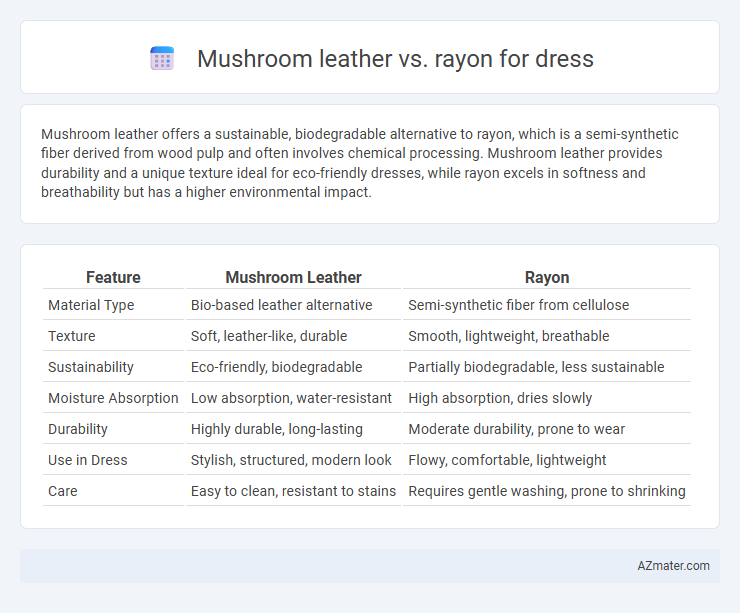Mushroom leather offers a sustainable, biodegradable alternative to rayon, which is a semi-synthetic fiber derived from wood pulp and often involves chemical processing. Mushroom leather provides durability and a unique texture ideal for eco-friendly dresses, while rayon excels in softness and breathability but has a higher environmental impact.
Table of Comparison
| Feature | Mushroom Leather | Rayon |
|---|---|---|
| Material Type | Bio-based leather alternative | Semi-synthetic fiber from cellulose |
| Texture | Soft, leather-like, durable | Smooth, lightweight, breathable |
| Sustainability | Eco-friendly, biodegradable | Partially biodegradable, less sustainable |
| Moisture Absorption | Low absorption, water-resistant | High absorption, dries slowly |
| Durability | Highly durable, long-lasting | Moderate durability, prone to wear |
| Use in Dress | Stylish, structured, modern look | Flowy, comfortable, lightweight |
| Care | Easy to clean, resistant to stains | Requires gentle washing, prone to shrinking |
Introduction to Sustainable Fabrics
Mushroom leather, derived from mycelium, offers an innovative, biodegradable alternative to traditional textiles, reducing environmental impact through low water usage and minimal chemical treatments. Rayon, a semi-synthetic fiber made from cellulose, provides softness and breathability but often involves intensive chemical processing and high energy consumption. Choosing mushroom leather over rayon for dresses supports sustainable fashion by promoting eco-friendly materials with fewer pollutants and enhanced durability.
What is Mushroom Leather?
Mushroom leather, also known as mycelium leather, is a sustainable, eco-friendly material crafted from the root structure of fungi, offering a biodegradable alternative to traditional leathers. It features a soft, flexible texture suitable for dressmaking, and provides a cruelty-free option with lower environmental impact compared to rayon, which is derived from chemically processed wood pulp. Mushroom leather's natural breathability and durability make it ideal for fashion applications seeking innovation and sustainability.
What is Rayon?
Rayon is a semi-synthetic fiber made from regenerated cellulose derived primarily from wood pulp, known for its smooth texture and breathability, making it popular in dress fabrics. Unlike mushroom leather, which is a sustainable alternative crafted from mycelium, rayon requires extensive chemical processing that can impact the environment. Dresses made from rayon offer a silky feel and drape similar to natural fibers but lack the durability and eco-friendliness associated with mushroom leather.
Production Process: Mushroom Leather vs Rayon
Mushroom leather is produced using mycelium, the root structure of fungi, which grows rapidly on organic substrates with minimal water and energy consumption, making it an eco-friendly alternative to traditional materials. Rayon, derived from cellulose fibers extracted from wood pulp, undergoes a chemically intensive process involving toxic solvents like carbon disulfide, resulting in higher environmental impact and resource use. The sustainable cultivation and low-waste production of mushroom leather position it as a greener option compared to the chemically dependent, energy-intensive manufacturing of rayon fabrics.
Environmental Impact Comparison
Mushroom leather offers a sustainable alternative to rayon, produced from mycelium with minimal water use and biodegradable properties, significantly reducing landfill waste. Rayon, derived from wood pulp through chemically intensive processes, involves high water consumption and pollution, contributing to deforestation and ecosystem degradation. Choosing mushroom leather for dresses supports a lower carbon footprint and promotes circular fashion by utilizing renewable resources and avoiding toxic chemicals.
Durability and Longevity
Mushroom leather offers superior durability and longevity compared to rayon, as it resists wear and tear while maintaining structural integrity over time. Its natural fibers provide resilience against stretching and fading, making it ideal for long-lasting dresses. Rayon, being a semi-synthetic fabric, tends to weaken with repeated washing and exposure to moisture, resulting in faster deterioration and reduced lifespan.
Comfort and Breathability
Mushroom leather offers superior breathability compared to rayon, allowing air to circulate more freely and reduce moisture buildup during wear. The natural properties of mushroom leather provide enhanced comfort by adapting to body temperature and offering a softer, more flexible texture than synthetic rayon fabrics. Rayon, while smooth, tends to retain heat and moisture, making mushroom leather a more breathable and comfortable choice for dress materials.
Design Versatility for Dresses
Mushroom leather offers exceptional design versatility for dresses due to its natural texture, flexibility, and eco-friendly properties, making it ideal for creating innovative and sustainable fashion pieces. Rayon provides a smooth, breathable fabric that enhances drape and comfort, allowing for diverse styles from casual to formal dresses. Both materials enable unique aesthetic possibilities, but mushroom leather stands out for its durability and organic appeal in cutting-edge dress designs.
Cost and Market Availability
Mushroom leather offers a sustainable, eco-friendly alternative to traditional textiles but tends to have higher production costs, making it pricier than rayon, which benefits from mass production and lower raw material expenses. Rayon is widely available on the market, with extensive global manufacturing and distribution networks supporting its affordability and accessibility in dressmaking. While mushroom leather remains a niche material with limited scale, its market is steadily growing as demand for sustainable fashion increases.
Future Prospects: Mushroom Leather vs Rayon
Mushroom leather, crafted from sustainable mycelium, offers a biodegradable and eco-friendly alternative to rayon, which is derived from chemically processed wood pulp. Future prospects for mushroom leather in dressmaking emphasize its lower environmental impact, durability, and unique texture, making it ideal for sustainable fashion. Innovations in mycelium cultivation and processing methods continue to enhance mushroom leather's scalability and affordability compared to rayon's established but resource-intensive production.

Infographic: Mushroom leather vs Rayon for Dress
 azmater.com
azmater.com